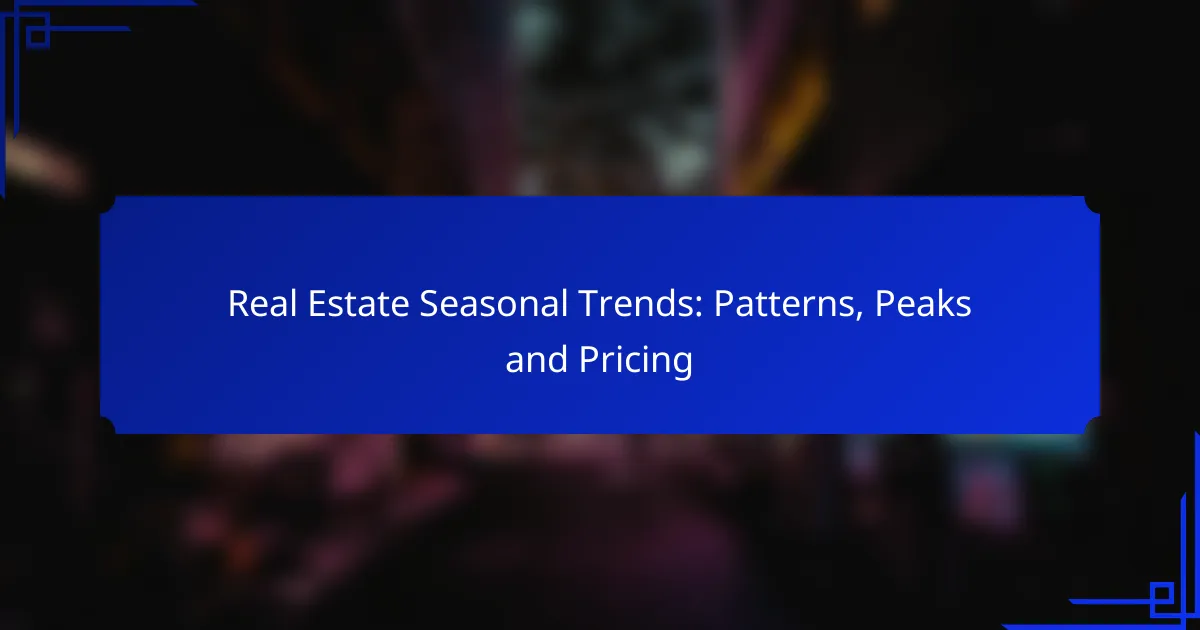Seasonal trends play a crucial role in shaping real estate pricing and activity in the US, with distinct patterns emerging throughout the year. Typically, the market experiences a surge in sales during the spring months, while winter sees a notable slowdown. By understanding these fluctuations, buyers and sellers can make strategic decisions about when to enter the market, potentially leading to better pricing and negotiation outcomes.

How do seasonal trends affect real estate pricing in the US?
Seasonal trends significantly influence real estate pricing in the US, with distinct patterns emerging throughout the year. Understanding these trends can help buyers and sellers make informed decisions about when to enter the market.
Spring peak pricing
Spring is typically the peak season for real estate pricing in the US, as many buyers are eager to purchase homes after the winter months. Listings often see increased demand, leading to higher prices, sometimes reaching double-digit percentage increases compared to winter.
During this time, homes tend to sell faster, often within weeks, as families look to move before the school year starts. Sellers can benefit from staging their homes and making necessary repairs to attract buyers and maximize their selling price.
Winter price dips
In contrast, winter usually brings a dip in real estate prices, as colder weather and holidays discourage many potential buyers. This seasonal slowdown can result in lower prices, sometimes in the range of 5-10% less than peak season prices.
For buyers, winter can present opportunities to negotiate better deals, as sellers may be more motivated to sell quickly. However, inventory is often limited, so buyers should be prepared to act fast when suitable properties become available.
Summer market stability
Summer often sees a stabilization of real estate prices, as the market remains active but does not reach the highs of spring. Prices may hold steady or experience slight fluctuations, typically within a few percentage points of spring pricing.
This season is popular for families looking to relocate, as it allows for smoother transitions before the new school year. Buyers should consider that competition can still be strong, and it’s essential to have financing pre-approved to make timely offers on desirable properties.

What are the key seasonal patterns in real estate sales?
Real estate sales experience distinct seasonal patterns, with activity typically peaking in spring and slowing down during winter months. Understanding these trends can help buyers and sellers make informed decisions about timing and pricing.
Increased activity in spring
Spring is often the most active season for real estate transactions, as warmer weather encourages more buyers to enter the market. Families often prefer to move during this time to settle before the new school year begins, leading to heightened demand.
During this season, properties tend to sell faster and at higher prices compared to other times of the year. Sellers can benefit from staging their homes effectively and listing them early in the season to attract potential buyers.
Slowdown in winter
Winter typically sees a significant slowdown in real estate activity, as cold weather and holiday distractions deter many buyers. This period often results in fewer listings and lower sales volume, which can lead to price reductions as sellers become more motivated to sell.
For buyers, winter can present opportunities to negotiate better deals, as sellers may be more willing to lower prices. However, the limited inventory means buyers might have fewer options to choose from, making it essential to act quickly when a suitable property becomes available.

How can buyers leverage seasonal trends for better deals?
Buyers can take advantage of seasonal trends by strategically timing their purchases to align with market fluctuations. Understanding when demand is lower can lead to better pricing and more favorable negotiation conditions.
Buying in off-peak seasons
Purchasing a home during off-peak seasons, typically in late fall and winter, can yield significant savings. During these months, inventory may be higher than demand, leading to lower prices and more room for negotiation.
For example, buyers may find properties listed at prices 5-15% lower than during peak seasons. Additionally, sellers in off-peak times are often more motivated, which can lead to better deals.
Timing offers during peak seasons
In peak seasons, usually spring and early summer, competition among buyers increases, often driving prices up. To navigate this, timing your offers strategically can make a difference. Consider making offers during the week rather than on weekends when more buyers are active.
Moreover, if you find a property that has been on the market for a while, submitting an offer slightly below the asking price can be effective, especially if the seller is eager to close quickly. Understanding local market conditions and trends can help you gauge the right timing for your offers.

What factors influence seasonal trends in real estate?
Seasonal trends in real estate are influenced by various factors, including weather conditions and the school year calendar. Understanding these elements can help buyers and sellers make informed decisions about when to enter the market.
Weather impacts
Weather significantly affects real estate activity, as many buyers prefer to house hunt during pleasant conditions. In regions with harsh winters, for example, the market often slows down, leading to fewer listings and transactions from late fall to early spring.
Conversely, spring and summer typically see a surge in activity as warmer weather encourages outdoor viewings and moving. Sellers may benefit from this trend by listing their properties during these peak months to attract more potential buyers.
School year cycles
The school year plays a crucial role in real estate trends, particularly for families with children. Many parents prefer to move during the summer months to avoid disrupting their children’s education, leading to increased demand for homes in late spring and early summer.
As a result, homes in good school districts often see higher prices and quicker sales during this period. Buyers should consider timing their purchases around the school calendar to maximize their options and negotiate better deals.

How do local markets vary in seasonal trends?
Local markets exhibit distinct seasonal trends influenced by factors such as climate, school schedules, and economic conditions. Understanding these variations can help buyers and sellers make informed decisions throughout the year.
Urban vs. suburban trends
Urban markets often experience peak activity in the spring and summer months, driven by young professionals and families eager to relocate. In contrast, suburban areas may see a more pronounced seasonal fluctuation, with heightened activity during the summer when families prefer to move before the school year starts.
Additionally, urban properties may have shorter selling cycles due to higher demand and limited inventory, while suburban homes might stay on the market longer, especially during the winter months when fewer buyers are active.
Regional pricing differences
Regional pricing trends can vary significantly based on local economic conditions and seasonal demand. For example, coastal cities often see higher prices during the summer tourist season, while inland areas may experience price drops in the winter months.
In the U.S., homes in warmer climates like Florida or California might maintain steadier prices year-round compared to colder regions where winter can slow down the market. Buyers should research local market conditions and historical pricing patterns to better anticipate seasonal changes.

What are the emerging trends in real estate seasonality?
Emerging trends in real estate seasonality indicate that market dynamics are increasingly influenced by factors such as remote work, economic fluctuations, and technological advancements. Understanding these trends can help buyers and sellers make informed decisions throughout the year.
Remote work influence
The rise of remote work has significantly altered real estate seasonality, with many buyers now prioritizing space and location over proximity to workplaces. This shift often leads to increased demand in suburban and rural areas, especially during spring and summer months when families prefer to relocate.
As remote work becomes more entrenched, seasonal peaks may flatten, resulting in a more consistent demand throughout the year. Buyers may seek homes with dedicated office spaces, influencing pricing and availability in certain markets.
Market recovery patterns
Market recovery patterns following economic downturns tend to show distinct seasonal trends. Typically, after a recession, the spring season sees a surge in activity as buyers return to the market, eager to capitalize on lower prices and favorable interest rates.
However, the timing of recovery can vary by region, influenced by local economic conditions and housing inventory. Understanding these patterns can help investors identify optimal times to buy or sell, particularly in markets that are rebounding more quickly than others.
Technology in seasonal analysis
Technology plays a crucial role in analyzing real estate seasonality, providing tools for data collection and trend forecasting. Advanced analytics platforms can track market fluctuations, allowing agents and buyers to make data-driven decisions based on seasonal patterns.
Utilizing technology such as predictive analytics can help identify when to enter or exit the market. For example, tools that analyze historical sales data can reveal the best months for listing a property, maximizing exposure and potential sale price.
